International experience11.09.2022
Open world in the "city of light"
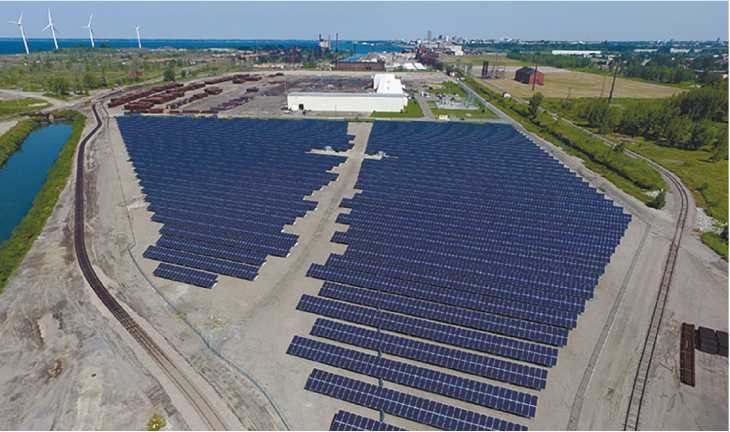
Timur Shalabayev, Executive Director of the Qazaq Green RES Association
A pandemic situation is making a mark in the history books. Business activity is being renewed, interest in new projects and initiatives is accelerating, borders are finally opening, exchange programs are being resumed. In May 2022, Timur Shalabayev, an Executive Director of the Qazaq Green RES Association took part in the short-term professional program called “Open World" funded by the US Congress, on the following topic: "Mass media coverage of the development of renewable energy sources." As part of this trip, the Kazakhstani delegation took part in the seminar of the US Congress Office on the International Leadership in Washington, DC, and also had the opportunity to get more acquainted with the initiatives of the State of New York in Buffalo to develop a sustainable economy.
The choice of location for the program for the Kazakh delegation was chosen purposefully. The city of Buffalo, like the whole State of New York, can be safely called an example of the development of the electric power industry. At the beginning of the 20th century, the population of the city themselves began to call it the "city of light." There were two important reasons for this name. Firstly, because of the construction of a hydroelectric power station on the Niagara Falls, which provided a huge amount of electricity. Secondly, Buffalo became the first American city to have a street with electrified lights.
In addition, at many meetings held during the exchange program, participants from the American side emphasized that the environmental movement in the United States takes its roots from this particular region of the country. This was primarily due to the rapid industrial development of the region in the 19th-20th centuries. Also, there were big consequences associated with environmental pollution, which directly affected and continue to affect the health of local residents.
Therefore, the Buffalo International Institute organized a very intense program with various stakeholders: the New York State Energy Authority, the Erie Department of Environmental Conservation and Planning, a visit to the Robert Moses Hydroelectric Power Plant and the Lewiston Hydroelectric Power Plant, the Buffalo Toronto Public Media Corporation, the University of Buffalo and several public non-governmental organizations.
Kazakhstani delegation at the Open World Program, Buffalo, New York

U.S. and New York State Power Network
In 2021, about 4,116 billion kWh of electricity was generated from electric power facilities in the United States of America. In comparison with Kazakhstan, in 2021, 114.3 billion kWh of electricity was generated at the country's power plants.
Overall, in the US, about 38% of this electricity generation comes from gas, 21.8% - from coal, and about 1% - from oil. At the same time, about 19% comes from the nuclear energy and about 20% comes from the renewable energy (of which WPP - 9.2%; HPP - 6.3%; SPP - 2.8%; BioPP - 1.3%; Geothermal energy - 0.4%). The US Energy Information Administration estimates that in 2021, an additional 49 billion kWh of electricity will be generated by small solar PV systems (less than 1 MW of installed capacity). As of December 31, 2020, there were 23,417 electrical generators in the United States operating at approximately 11,070 industrial power plants.
Electricity generation by types of resources in the USA in 2021

Source: U.S. Energy Information Administration
There are currently two major AC power networks in the US: Eastern Interconnection and Western Interconnection. In addition to them, there are two small power systems: Alaska Interconnection (in Alaska) and Texas Interconnection (in Texas). The three grids, Eastern, Western, and Texas, are connected to each other via DC links, allowing power to be sent across the continental US, to Canada, and to Mexico.
In 2021, carbon dioxide (CO2) emissions from the US electricity sector were 1,551 million metric tons (Mt), or about 32% of total US energy-related CO2 emissions of 4,872 (Mt). Coal plants account for 59%, gas plants - for 40%, and oil plants - for 1%.
Since 2012, natural gas, nuclear and hydropower together have provided more than nine-tenths of New York State's net industrial-scale electricity generation (1 megawatt or more). Non-hydroelectric renewable resources such as wind, biomass, and solar power provide most of the remaining energy resources.
In 2019, New York State revised its Clean Energy Standards to move to 100% carbon-free electricity from both renewable and nuclear power by 2040.
According to the results of the data on electricity generation in February 2022, 45% of electricity generation in New York State comes from gas, 23% each from hydroelectric and nuclear power plants, about 8% - from renewable energy, and about 1% - from oil. In 2019, New York was the sixth largest consumer of natural gas among all states. Today, three out of five households in the state use natural gas to heat their homes.
All in all, the share of nuclear energy in the energy system of the state is declining. In 2019, Nuclear power plants accounted for 34% of New York State's electricity generation. This is due to the 2021 closure of Indian Point, one of the state's four nuclear power plants.
Electricity generation at the end of February 2022 in the New York State

Source: U.S. Energy Information Administration
Coal was a small source of New York State's electricity generation. Coal-fired generation, which was about one-sixth of the state's output two decades ago, provided only 0.1% of New York State's electricity in 2020 when the state's last coal-fired power plant, located on the shores of Lake Ontario, was closed.
US Renewable Energy and New York State Plans
Renewable electricity production from sources other than hydroelectricity has grown steadily in recent years, mainly due to the addition of wind and solar generating capacity. Since 2014, the total annual production of electricity from non-hydro industrial-scale renewable sources has exceeded the total annual electricity production from hydroelectric power plants.
Wind power's share of total industrial power generation capacity in the United States has risen from 0.2% in 1990 to about 12% in 2021, and its share of total annual industrial power generation has risen from less than 1 % in 1990 to about 9% in 2021.
Despite a relatively small share of total U.S. power and generation, solar power capacity and generation have grown significantly in recent years. Solar power generation capacity on an industrial scale has grown from about 314 MW in 1990 to about 61,014 MW at the end of 2021, of which about 98% was from solar photovoltaic systems and 2% from solar thermal power systems.
The share of solar energy in total U.S. electricity generation in 2021 was about 2.8%, compared to less than 0.1% in 1990, and small-scale photovoltaic generation was about 49 billion kWh.
Map of renewable energy facilities in the USA

Source: U.S. Energy Information Administration
In 2019 New York State passed the Climate Leadership and Community Protection Act. The law sets targets to reduce emissions by 40% from 1990 levels by 2030 and then to 85% from 1990 levels by 2050. The remaining 15% of emissions will be offset, for example, by planting trees that remove carbon dioxide from the air to achieve net zero emissions.
One of the key principles to achieve this goal is the energy transition in the New York State. By 2030, New York City plans to get 70% of its electricity from renewable sources, and by 2040, the goal is for all of the state's electricity to come from carbon-free sources such as wind, solar, and water.
The legislation also requires the state's entire economy to be carbon fre by 2050. Under the Clean Energy Standard, the state's nuclear power plants qualify as zero-emission resources. Properties that are not technically capable of eliminating all carbon emissions may purchase offsets for a fraction of the 100% carbon neutrality required to achieve the goal. Compensation should be from nearby sources that reduce carbon emissions, such as forests and agriculture. In 2018, energy-related carbon emissions per capita in the New York State were lower than in any other state in the country.
In 2020, for the first time, renewables produced more electricity than nuclear power plants in the New York State. Hydroelectricity provided almost a quarter of the New York State's net electricity generation. Wind, biomass, and solar power provided nearly all of the rest of the state's renewable generation. The contribution of both industrial and small-scale (less than 1 megawatt) solar photovoltaic (PV) generators has increased substantially over the past decade and exceeded the amount of electricity generated from biomass in 2019 for the first time.
New York is consistently ranked among the top four hydroelectric producers in the country, and in 2020 the state produced more hydroelectric power than all other states except two states, Washington and Oregon. The Robert Moses Hydroelectric Power Plant produces the largest share of New York City's hydropower. The station is the third largest conventional hydroelectric plant in the United States.
Robert Moses HPP (foreground) and Lewiston PSP (background)
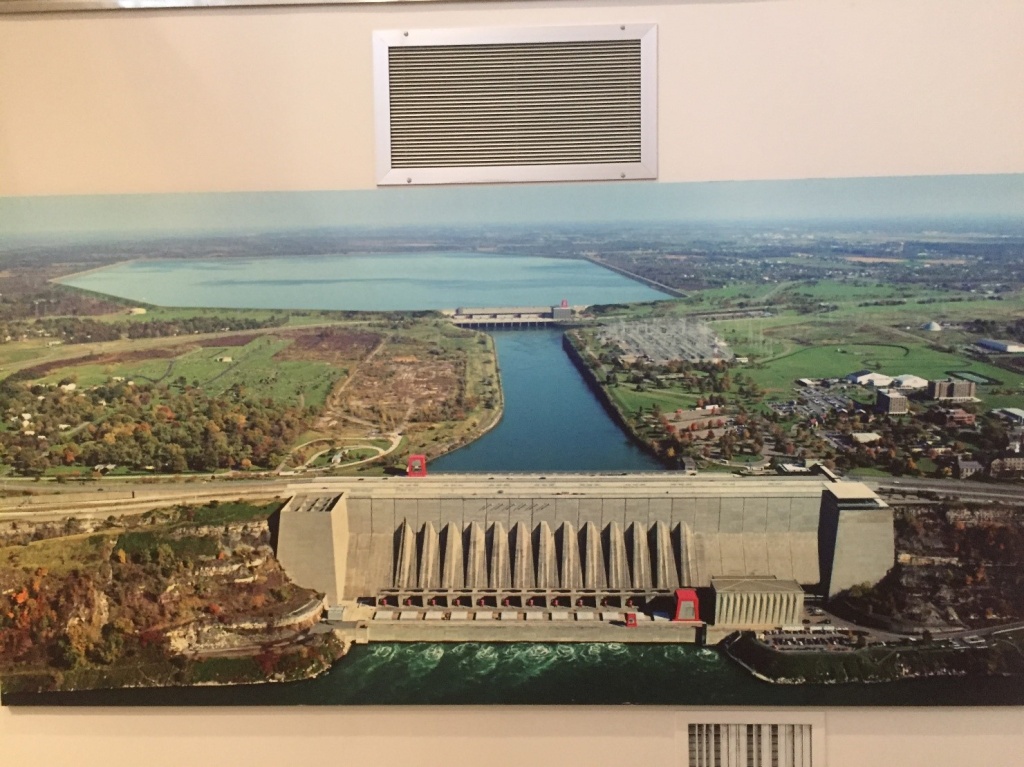
Practically both stations are an example of base (HPP named after Robert Moses) and flexible generation PSP (Lewiston pumped storage power plant). The Lewiston PSP has a water tank, which is located on an area of 770 hectares. At night, with the help of pumps, when the demand for electricity is reduced and tariffs are much lower than during the day, electricity is used from the nearby HPP. Robert Moses to fill the reservoir. During the day, at the command of the system operator, the 12,240-MW turbines of the Luston Pumped Storage Plant use water from the reservoir to regulate the State's power grid. At the same time, the 2,535-MW Robert Moses HPP effectively acts as the base power generation for the entire state and covers about 25% of the electricity demand. Both stations are interconnected and can practically supply 2.6 GW of power to the system.
Wind is New York's second largest renewable source of clean electricity. In 2020, wind energy accounted for almost 4% of all useful generation in New York. As of June 2021, New York had a total of about 2,000 megawatts of wind power from almost 24 wind farms. The state is in the process of applying to develop 9,000 megawatts of offshore wind power by 2035. As of 2020, there were over 4,300 megawatts of offshore wind power in development in New York.
In 2020, solar power provided 2.5% of New York's total net power generation, two-thirds of which came from small systems less than 1 MW each. New York encourages small solar installations, such as rooftops, through net metering and various financial support programs. In 2020, the state ranked fifth in the nation in small-scale solar power generation. Most of the state's more than 240 commercial solar installations are under 20 MW, but there are three large solar installations with over 20 megawatts. All of them are located on Long Island. Between January 2020 and June 2021, about a quarter of New York City's commercial-scale solar capacity was commissioned. In mid-2021, New York State had nearly 2,700 MW of installed PV capacity. The next goal is to reach from 3000 megawatts of solar photovoltaic capacity by 2023 to 6000 megawatts by 2025.
New York State Sustainable Energy Initiatives
As part of the exchange program, a meeting was held with the Erie County Department of Environment and Planning. In general, it must be said that Buffalo was a major industrial site. Since the end of the 19th century, heavy industry has been developing here: the production of steel, coke, the chemical industry, etc. This was facilitated by the use of the Erie Canal for transport purposes. South of the city in the locality of Lackawanna was a large industrial site, where the largest steel corporation in the world, Bethlehem Steel Plant, was operating. In the early 1980s the plant was closed, the soil under the plant, as well as the environment in the surrounding area, was poisoned. At the same time, the expansion of the city prompted the local government to decide on the further use of these areas, since reclamation and cleanup would be very expensive for the local budget. The solution was found within the framework of the sustainable development program - it was decided to organize a renewable energy zone on the site of the former steel production.
Wind and solar park on the site of an industrial site Bethlehem Steel Plant
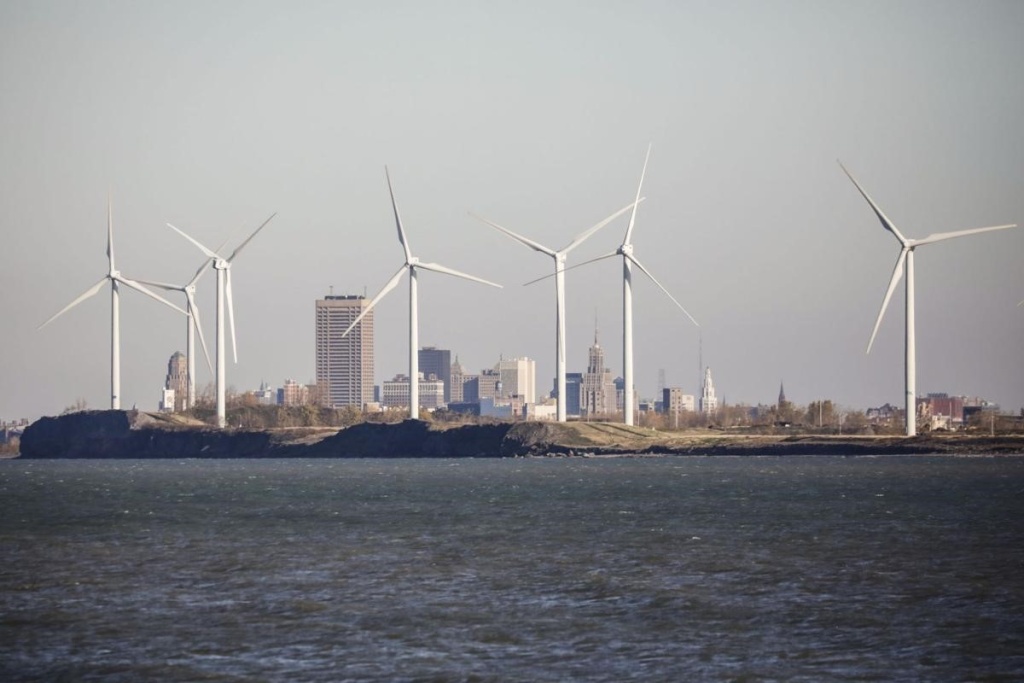
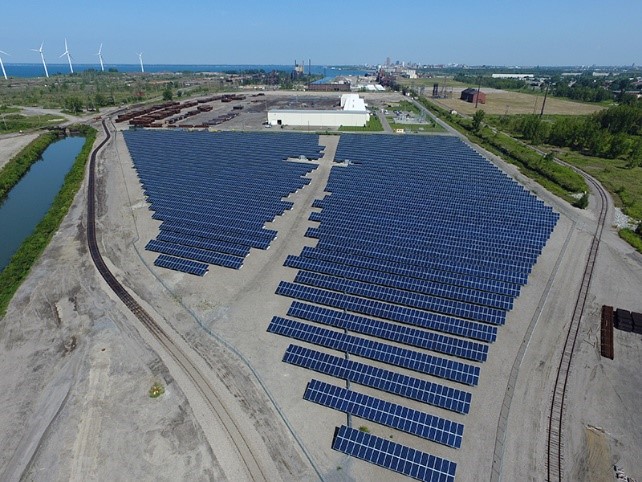
Currently, 35-MW wind power plant and 8.8-MW solar power plant have been built here with plans for further expansion. Since they received a cheap source of energy, they are now considering the possibility of cheap renewable electricity being sold to the urban poor in the first place.
Equally interesting is the commitment to sustainable development goals of the University of Buffalo. The university has a separate department responsible for sustainable development. Over the past three years, the University at Buffalo has reduced its carbon footprint by an average of 33% (measured in metric tons of carbon dioxide equivalent) by replacing 671,594,561 kilowatt-hours of electricity with renewable sources. Case studies of the implementation of the university's sustainability policy are the realization of projects of two solar systems on campus, the 4.5-MW Steel Winds project off campus in Buffalo, the implementation of the Buffalo Future of Renewable Energy Localization initiative, and the purchase of 100% of the electricity consumed from carbon credits from renewable energy stations. The goal of the university is to switch to 100% electricity consumption through renewable energy sources by 2030.
Solar Station at the University of Buffalo
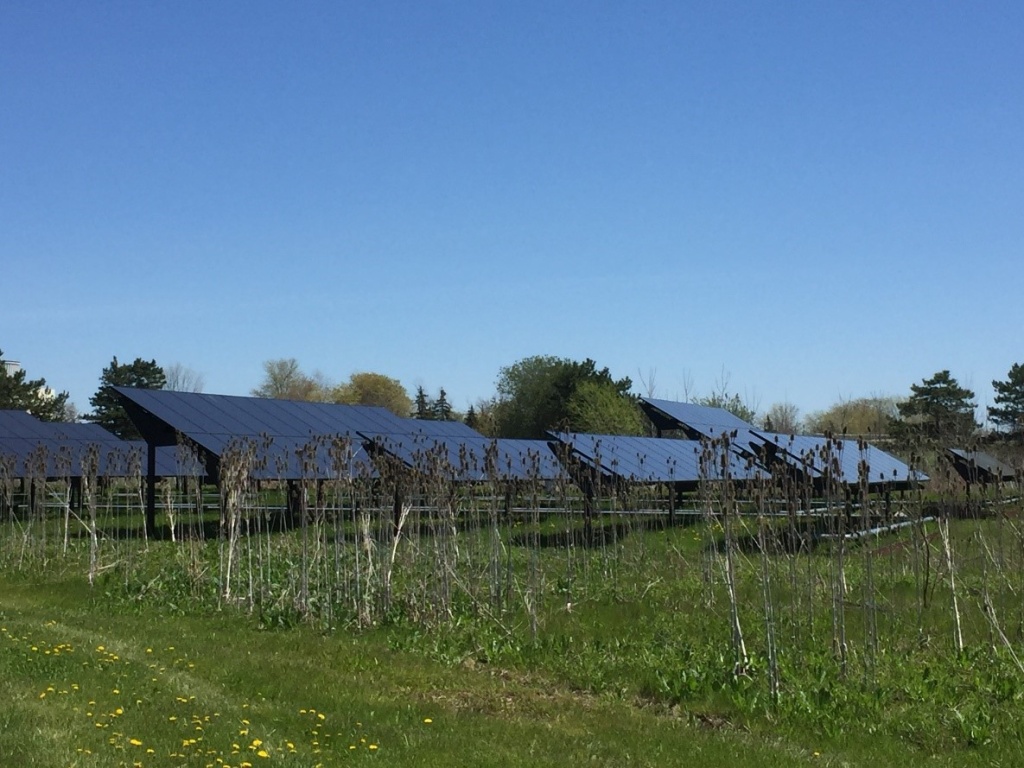
Activity of civil society and associations
During the program, meetings were also held with a number of non-governmental organizations and associations that were actively involved in environmental protection, protection of the local community interests, and development of the clean energy. Among them were such organizations as: Citizens' Campaign for the Environment, Open Buffalo, Clean Air Coalition, Sierra Club.
One of the most memorable meetings was the presentation of activities of the Erie Clean Air Coalition in New York State. The coalition presented interesting cases of its activities, approaches to solving the problems of which could also be of interest to us.
For example, in the Erie region, the 780-MW Huntley coal plant was closed in 2016. The thermal power plant was closed due to economic reasons - coal energy has become expensive and unprofitable. According to the report by the Institute of Energy Economics and Financial Analysis (IEEFA), Huntley's pre-tax profit fell by $113 million between 2008 and 2012; and the plant has posted an average annual loss of $1 million more recently. Because the station was the largest taxpayer in the region, the Erie area lost a lot of government revenue. For example, between 2008 and 2012 due to low tax revenues, three public schools in Thanawanda were closed. The closure of the plant as a whole reduced the tax revenue of the City of Tonawanda, Erie County, and the Kenmore Tonawanda School District by US$6.2 million. The government of the region turned to the government of the State, which, in order to solve the problem with the deficit in budget revenues, founded the Fund (Electric Generation Facility Cessation Mitigation Fund), which would cover this deficit. The fund was launched as part of the 2016-2017 state budget, with the New York State initially providing $30 million to help communities that are losing property tax revenue due to the plant's closure. In April 2018, another $24 million was added to the program, with a balance of $56 million as of October 2020. The program uses proceeds from the Regional Greenhouse Gas Initiative to compensate counties, towns, cities, school districts, and special district payments for a period of 7 years.
Huntley Coal Power Plant, Tonawanda, New York
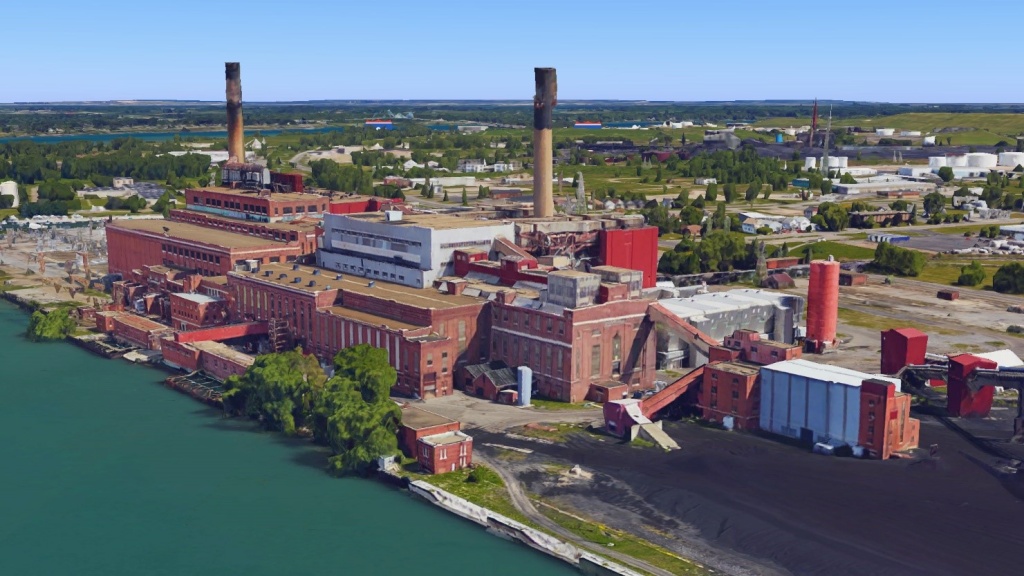
Until now, the power plant building and all surrounding areas belong to the company. Now the Coalition has raised the issue for the State to exercise its legislative right and sell all buildings and territory for $1 for the needs of the local community (legislation thus allows the removal of inactive assets for the needs of the population). Since this plant was very polluting and caused many types of cancer (brain, esophagus, lung cancer) among the local population, and people live here already at a distance of 1 mile, all residents through civil organizations want to force the owner's company to demolish the plant at their own expense and make a complete cleaning of the territory in accordance with environmental requirements. Why? Because the local budget has been paying for healthcare services and treatment of cancer patients for many years.
One of the most important problems was the issue of re-employment of people who worked at the coal plant. The coalition involved trade unions in this work, with the help of which people were retrained at the expense of trade union funds and re-employed. At the same time, state funding was not used for these purposes.
Another interesting case was with the Fortistar gas power plant. Now the plant works as a maneuvering power to smooth out daily schedules in the network and is a balancing power, that is, it turns on only during peak hours. The management of the plant decided to maximize profits and run a mining farm in order to increase their income and practically generate profit 24/7. The Coalition for Clean Air joined the project. Since gas-generated energy also pollutes the air and causes diseases of the local population. They took advantage of the State Zoning Act, which is trying to ban mining activity in the Erie area. Currently, they have prepared a bill that will introduce a moratorium for two years on this activity and will oblige to conduct a full study of the impact of mining on electricity consumption, and as a result, the intensification of environmental pollution and the impact on the health of the local population.
Forstistar gas plant in North Tonawanda, New York
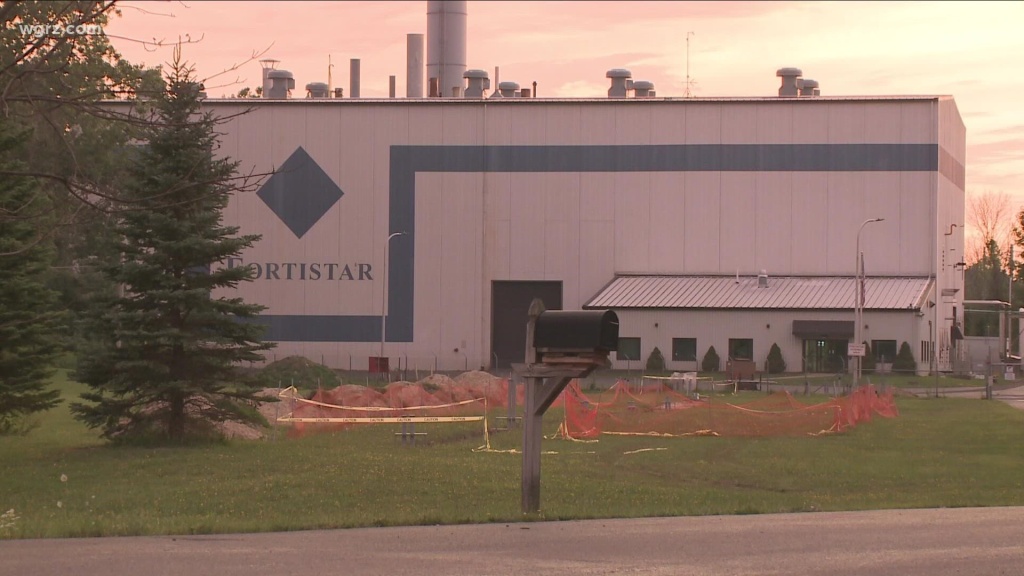
Civic activists point to the case of a closed plant in Dresden, where a former coal plant was trying to reopen its operations for mining cryptocurrencies using natural gas.
Conclusion
In general, the energy system of the state of New York is the desired balance of resources, which they are trying to find responsible persons for the development of energy in Kazakhstan. Economic realities, the unprofitability of coal-fired generation, cheap gas prices have led to the closure of coal-fired stations and the development of gas-fired power generation. At the same time, sustainable development of hydropower and nuclear power should be noted as the basic generation. On this note, the ambitious plans for the development of renewable energy and practical plans to achieve the goal of net-zero emissions by the state by 2040 are certainly understandable.
Talking to stakeholders representing various organizations in the New York State, one can understand the great power that comes from civic engagement and non-governmental organizations that raise important issues for the local community. Thanks to this, at the level of ordinary citizens and communities there is an understanding of the goals and need for the development of the clean energy. Standing up for one's rights, protecting the environment, protecting the health of loved ones, understanding responsible coexistence with nature and a clear vision of a clean future are the hallmarks of the citizenship of modern and advanced Americans. It seems that this is where the secret of success in sustainable development in the "city of light" lies.
Trump signs executive order to end subsidies for wind and solar energy
Uzbekistan's solar and wind power plants generate 5 Billion kWh since beginning of the year
Green Corridor Alliance JV registered in Baku to promote green energy development in Central Asia and the South Caucasus
In the EU renewable energy supply grew by 3.4% in 2024
IRENA accepting renewable energy project proposals in Central Asia until August 15
Astana to host Electronica Expo Kazakhstan Electronics Exhibition
WB gives rundown of Azerbaijan's green energy grid volume prospects
US solar sets new records as renewables nearly match natural gas – EIA
‘Wings’ on poles: Bill Gates-backed breakthrough wind turbine facility breaks ground
Perovskite tandem solar cell achieves new efficiency record
Kazakhstan and China endorse draft SCO joint statement on sustainable energy development
Innovative research on organic solar cells for space applications
Kazakhstan and Uzbekistan drive green energy progress in Central Asia
KazMunayGas launches pilot green hydrogen project in Atyrau
How private homeowners in Kazakhstan can make money from solar panels
14 countries are investing in Kazakhstan's renewable energy sector through auctions
How green hydrogen could transform Kazakhstan’s energy sector
IKEA offers ready-to-use solar power systems for balconies
Adani commissions India’s first off-grid green hydrogen pilot plant
Tajikistan unveils green energy roadmap at international conference in Dushanbe











